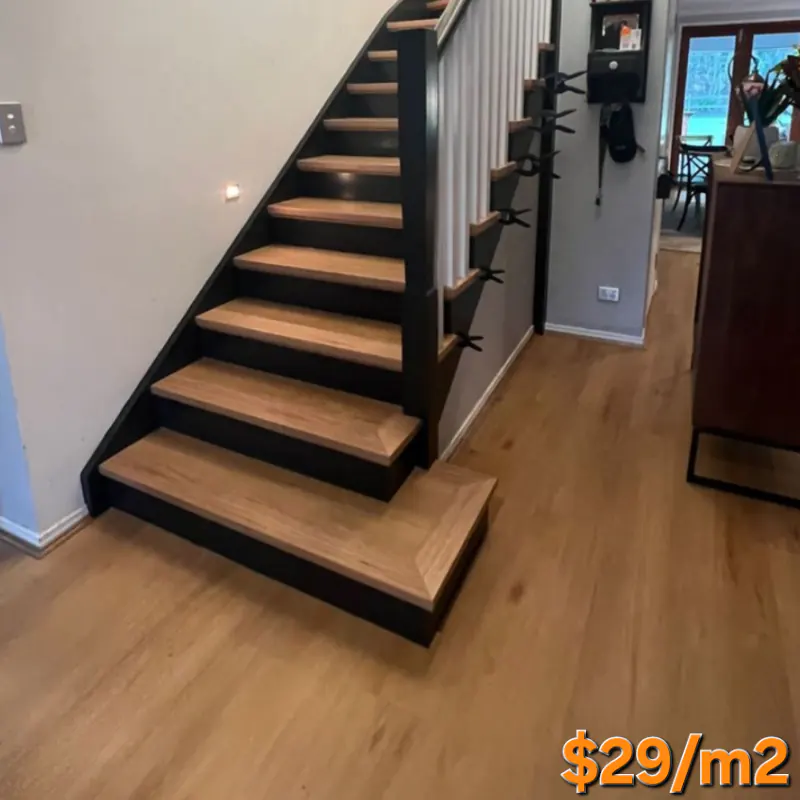
Choosing resilient, long-term residential, commercial or business flooring can be confusing and intimidating. Nowadays, many Australians prefer engineered timber, hybrid, or laminate flooring.
Each of these floor types has distinct advantages and disadvantages. As hybrid flooring Sydney experts with extensive industry experience, Ezy Decking recommends thoroughly understanding each flooring type to determine which option suits your unique lifestyle preferences.
Engineered Timber Flooring
Engineered timber flooring is a versatile, robust alternative that combines timber’s natural aesthetics with increased durability. Unlike solid timber flooring, which is made from one wooden piece, engineered timber is designed to prevent issues such as warping and gapping, guaranteeing a durable, long-lasting flooring solution.
Engineered timber has several layers:
- Wear layer: This layer consists of the customer’s preferred timber species, such as Australian oak, European white oak, Jarrah, Rosewood, and Merbau. Homeowners can sand or refinish the wear layer a limited number of times, depending on the manufacturer’s specifications.
- Core layer: This layer runs perpendicular to the top one. Some engineered timber flooring brands use plywood or spruce.
- Bottom layer: Manufacturers use resilient materials such as hardwood or plywood to increase stability and moisture resistance.
This multiple-layer orientation enhances the flooring’s resistance to climate and humidity changes. However, please remember that engineered timber flooring quality, layer thickness, and the core material vary depending on the manufacturer. Premium types’ superior-quality coating and sturdy cores ensure longevity and durability.
Engineered timber floors are pricier than traditional hardwood counterparts. The former is also not 100% scratch-resistant. Nevertheless, their durability, stability, and longevity make them a worthy investment for many Australian homeowners.
Laminate Flooring
Laminate flooring is a multi-layer floor manufactured from wood fibre and a cost-effective alternative to engineered timber. The former has become more popular among homeowners because of its endurance and ease of use. Today’s technology and innovative measures have resulted in premium laminates that mimic genuine, authentic timber, resulting in a unique, high-quality appearance at a fraction of the price.
Laminate’s three layers include the following:
Premium decorative layer
This layer contains the printed image with colourful designs and patterns that enhance homeowners’ indoor aesthetics.
The decorative layer also shields the surface from scratching and fading, making laminate flooring an excellent choice for high-traffic areas such as living rooms, open kitchens, or flats with pets.
Core board
This layer is composed of high-density fibreboard, which enhances the laminate floor’s structural integrity and moisture resistance. The core board resists large furniture without denting.
Bottom layer
This protective layer shields the core board from moisture and stabilises the flooring’s structure.
Laminate flooring is a robust alternative for homes and light commercial traffic spaces. Its water-resistant and water-repellent characteristics ensure longevity.
The appeal of laminate flooring depends on the photo quality of the top layer. Inferior or substandard photos may compromise the floor’s authenticity.
A damaged or worn top layer prevents users from sanding and refinishing the laminate flooring, which is thinner than wood. Finally, laminate floors are hard to repair: one severely damaged plank means homeowners must replace the entire flooring.
Hybrid Flooring
Hybrid flooring is a relatively new industry development that combines the benefits of laminate and vinyl floors. Laminate flooring is not waterproof and can swell.
Conversely, although vinyl flooring is moisture-resistant, it can be challenging to install because homeowners must glue the planks to the floor. Fortunately, hybrid flooring combines the strengths of these two floor types without their shortcomings.
Hybrid flooring has four layers:
- Top layer: Manufacturers coat the top layer with ultraviolet (UV) coating for endurance and impact resistance. It also helps prevent wear and tear from frequent use.
- Decorative layer: This layer mimics the appearance and aesthetics of timber flooring.
- Limestone composite core board: This layer helps the flooring resist water and extreme temperatures.
- Underlay: Manufacturers pre-adhered the underlay to hybrid flooring to absorb sound and provide comfort. Since the underlay is already built into the flooring, homeowners don’t need to add one during installation, saving time and effort.
Hybrid flooring is more straightforward to assemble and repair than other floor types. Using minimal equipment and a simple click-and-lock mechanism, you can lay the planks over a flat, smooth surface, making installation and maintenance a breeze.
Manufacturers recommend a few millimetres of expansion joints between blanks because hybrid flooring doesn’t expand as much as other flooring types.
Easier to fix
Unlike laminate flooring, hybrid floors are easier to fix. Homeowners can remove one damaged plank and replace it with a new one. Hybrid flooring is a cost-effective, stylish, durable, and low-maintenance option worth considering.
Hybrid flooring isn’t perfect. Although resilient, it can develop scratches or dents, especially when homeowners frequently shift large furniture. Regular sanitation using neutral cleaners helps prevent scratching and denting and preserves your flooring’s aesthetics.
Discolouration
Frequent exposure to intense sunlight or artificial light and the use of latex and rubber mats can discolour hybrid flooring. Please use curtains or blinds to shield your flooring from harsh lighting. On the other hand, braided, non-staining mats are an excellent alternative to the latex and rubber versions.
Some hybrid flooring types are made from harmful plastics, which can release hazardous compounds that compromise health and air quality. Please select flooring that has no toxic elements for your peace of mind and comfort.
Lastly, hybrid flooring’s plastic component is less aesthetically appealing to homeowners than the timber and laminate types.
Our Most Popular Herringbone Hybrid Flooring Styles
Be sure to view the most popular herringbone hybrid flooring styles among our customers:
- Natural Oak Herringbone Hybrid Flooring
- Blackbutt Herringbone Hybrid Flooring
- Hamptons White Herringbone Hybrid Flooring
Conclusion
Choosing the appropriate flooring for your home or commercial space can be intimidating. However, thoroughly understanding the features, benefits, and disadvantages of engineered timber, laminate, and hybrid flooring will provide valuable insight to make a sound, long-term buying decision.
With over 25 years of industry experience, Ezy Decking is a reliable hybrid flooring Brisbane specialist that manufactures and sells resilient, cost-effective flooring that endures and improves the aesthetics of your indoor space.





